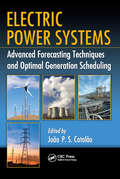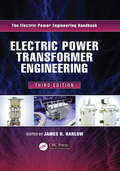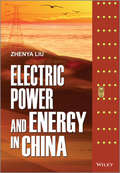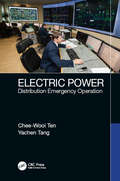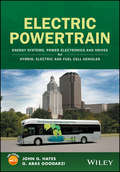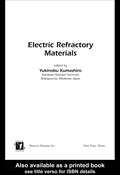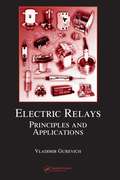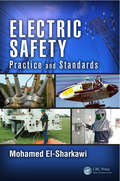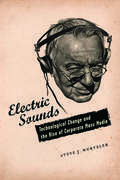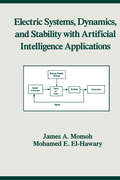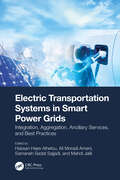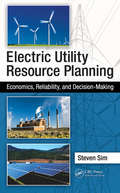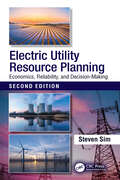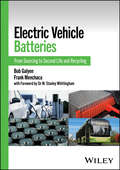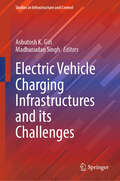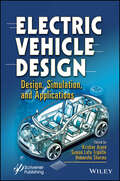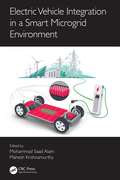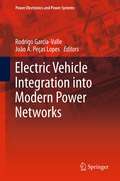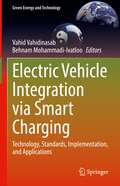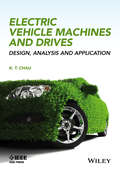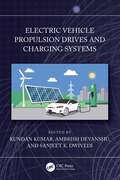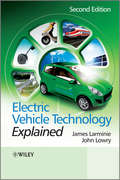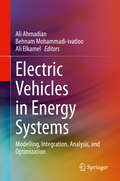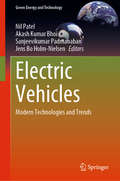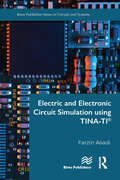- Table View
- List View
Electric Power Systems: Advanced Forecasting Techniques and Optimal Generation Scheduling
by João P. S. CatalãoElectric Power Systems: Advanced Forecasting Techniques and Optimal Generation Scheduling helps readers develop their skills in modeling, simulating, and optimizing electric power systems. Carefully balancing theory and practice, it presents novel, cutting-edge developments in forecasting and scheduling. The focus is on understanding and solving pivotal problems in the management of electric power generation systems. Methods for Coping with Uncertainty and Risk in Electric Power Generation Outlining real-world problems, the book begins with an overview of electric power generation systems. Since the ability to cope with uncertainty and risk is crucial for power generating companies, the second part of the book examines the latest methods and models for self-scheduling, load forecasting, short-term electricity price forecasting, and wind power forecasting. Toward Optimal Coordination between Hydro, Thermal, and Wind Power Using case studies, the third part of the book investigates how to achieve the most favorable use of available energy sources. Chapters in this section discuss price-based scheduling for generating companies, optimal scheduling of a hydro producer, hydro-thermal coordination, unit commitment with wind generators, and optimal optimization of multigeneration systems. Written in a pedagogical style that will appeal to graduate students, the book also expands on research results that are useful for engineers and researchers. It presents the latest techniques in increasingly important areas of power system operations and planning.
Electric Power Transformer Engineering
by Alice Wilmere Norton ShawElectric Power Transformer Engineering, Third Edition expounds the latest information and developments to engineers who are familiar with basic principles and applications, perhaps including a hands-on working knowledge of power transformers. Targeting all from the merely curious to seasoned professionals and acknowledged experts, its content is structured to enable readers to easily access essential material in order to appreciate the many facets of an electric power transformer. Topically structured in three parts, the book: Illustrates for electrical engineers the relevant theories and principles (concepts and mathematics) of power transformers Devotes complete chapters to each of 10 particular embodiments of power transformers, including power, distribution, phase-shifting, rectifier, dry-type, and instrument transformers, as well as step-voltage regulators, constant-voltage transformers, transformers for wind turbine generators and photovoltaic applications, and reactors Addresses 14 ancillary topics including insulation, bushings, load tap changers, thermal performance, testing, protection, audible sound, failure analysis, installation and maintenance and more As with the other books in the series, this one supplies a high level of detail and, more importantly, a tutorial style of writing and use of photographs and graphics to help the reader understand the material. Important chapters have been retained from the second edition; most have been significantly expanded and updated for this third installment. Each chapter is replete with photographs, equations, and tabular data, and this edition includes a new chapter on transformers for use with wind turbine generators and distributed photovoltaic arrays. Jim Harlow and his esteemed group of contributors offer a glimpse into the enthusiastic community of power transformer engineers responsible for this outstanding and best-selling work. A volume in the Electric Power Engineering Handbook, Third Edition. Other volumes in the set: K12642 Electric Power Generation, Transmission, and Distribution, Third Edition (ISBN: 9781439856284) K12648 Power Systems, Third Edition (ISBN: 9781439856338) K13917 Power System Stability and Control, Third Edition (9781439883204) K12650 Electric Power Substations Engineering, Third Edition (9781439856383) Watch James H. Harlow's talk about his book: Part One: http://youtu.be/fZNe9L4cux0 Part Two: http://youtu.be/y9ULZ9IM0jE Part Three: http://youtu.be/nqWMjK7Z_dg
Electric Power and Energy in China
by Zhenya LiuThe acute energy problems facing China today are characterized by their own histories and realities. Some have come about because of China's energy endowment and stage of development, while others have been created by a combination of domestic and global factors. Some are the results of an accumulation of longstanding contradictions, while others are new challenges posed by the new order. There are no "miracle cures" to solve these problems instantly. What is needed is a tireless enquiry, with goals, planning and procedures, guided by a clear energy strategy. With China's increasing dependence on foreign energy sources, and the global energy situation and greenhouse gas issue exerting an increasingly prohibiting effect on China's energy development, energy diplomacy has become an important component of Chinese diplomatic affairs. Based on a "broad energy outlook", this book studies and analyzes China's energy issues and energy strategies from the perspective of electric power. Discusses a variety of issues, including energy transportation and allocation, end-user consumption, markets, early warning and emergency, technical innovation As a leading player in the power and energy area, China’s strategies attracts global attention Proposes the innovative idea of "Macro Energy Perspective" As a key player in China's energy industrial circle, the author's perspective can help global audiences to understand China's energy strategies better Electric Power and Energy in China is ideal for government energy policy makers, engineers, scientists and enterprise managers to understand China’s strategy in electric power and energy. It is also a good reference for energy economics researchers, consultants and university students.
Electric Power: Distribution Emergency Operation
by Chee-Wooi Ten Yachen TangProvides the fundamentals of distribution emergency operation using graph-theoretic approach and exploration of subsystem(s) that address the operational aspects of fault occurrence to determine the possible feeder reconfiguration. Topics include: (1) Data extraction from geographic information systems (GIS), (2) Graph modeling of distribution feeders, (3) Programming for backward/forward sweeping unbalanced power flow, (4) Short circuit analysis and fault localization, (5) Fault isolation and service restoration, (6) Outage management and crew coordination, (7) Trouble call tickets and escalation to search for fault, and (8) Emerging topics of distribution management systems (DMS).
Electric Powertrain: Energy Systems, Power Electronics and Drives for Hybrid, Electric and Fuel Cell Vehicles
by John G. Hayes G. Abas GoodarziEmpowers engineering professionals and students with the knowledge and skills required to engineer electric vehicle powertrain architectures, energy storage systems, power electronics converters and electric drives. The modern electric powertrain is relatively new for the automotive industry, and engineers are challenged with designing affordable, efficient and high-performance electric powertrains as the industry undergoes a technological evolution. Co-authored by two electric vehicle (EV) engineers with decades of experience designing and putting into production all of the powertrain technologies presented, this book provides readers with the hands-on knowledge, skills and expertise they need to rise to that challenge.This four-part practical guide provides a comprehensive review of battery, hybrid and fuel cell EV systems and the associated energy sources, power electronics, machines, and drives. The first part of the book begins with a historical overview of electromobility and the related environmental impacts motivating the development of the electric powertrain. Vehicular requirements for electromechanical propulsion are then presented. Battery electric vehicles (BEV), fuel cell electric vehicles (FCEV), and conventional and hybrid electrical vehicles (HEV) are then described, contrasted and compared for vehicle propulsion. The second part of the book features in-depth analysis of the electric powertrain traction machines, with a particular focus on the induction machine and the surface- and interior-permanent magnet ac machines. The brushed dc machine is also considered due to its ease of operation and understanding, and its historical place, especially as the traction machine on NASA’s Mars rovers. The third part of the book features the theory and applications for the propulsion, charging, accessory, and auxiliary power electronics converters. Chapters are presented on isolated and non-isolated dc-dc converters, traction inverters, and battery charging. The fourth part presents the introductory and applied electromagnetism required as a foundation throughout the book. • Introduces and holistically integrates the key EV powertrain technologies.• Provides a comprehensive overview of existing and emerging automotive solutions.• Provides experience-based expertise for vehicular and powertrain system and sub-system level study, design, and optimization.• Presents many examples of powertrain technologies from leading manufacturers.• Discusses the dc traction machines of the Mars rovers, the ultimate EVs from NASA.• Investigates the environmental motivating factors and impacts of electromobility.• Presents a structured university teaching stream from introductory undergraduate to postgraduate.• Includes real-world problems and assignments of use to design engineers, researchers, and students alike.• Features a companion website with numerous references, problems, solutions, and practical assignments.• Includes introductory material throughout the book for the general scientific reader.• Contains essential reading for government regulators and policy makers.Electric Powertrain: Energy Systems, Power Electronics and Drives for Hybrid, Electric and Fuel Cell Vehicles is an important professional resource for practitioners and researchers in the battery, hybrid, and fuel cell EV transportation industry. The book is a structured holistic textbook for the teaching of the fundamental theories and applications of energy sources, power electronics, and electric machines and drives to engineering undergraduate and postgraduate students.Textbook Structure and Suggested Teaching CurriculumThis is primarily an engineering textbook covering the automotive powertrain, energy storage and energy conversion, power electronics, and electrical m
Electric Refractory Materials
by Yukinobu KumashiroAn exploration of electric refractory materials, this book covers developments of blue light-emitting diodes using GaN-based nitrides for laser and high-temperature and -frequency devices. Electric Refractory Materials introduces growth and evaluation standards of films and bulk crystals, with consideration of band structure, surface electronic structure, and lattice vibrations. It also covers heat capacity and thermal conductivity, irradiation properties, and selective surfaces. Focusing on diamond material, the book examines its synthesis and characterization as well as its electrical, optical, and conductive properties. The book also discusses the use of silicon carbide, boron compounds, and other material used in electronic and light-emitting devices.
Electric Relays: Principles and Applications (Electrical and Computer Engineering #Vol. 130)
by Vladimir GurevichElectric relays pervade the electronics that dominate our world. They exist in many forms, fulfill many roles, and each have their own behavioral nuances and peculiarities. To date, there exists no comprehensive reference surveying the broad spectrum of electric relays, save one-Electric Relays: Principles and Applications. This ambitious work is not only unique in its scope, but also in its practical approach that focuses on the operational and functional aspects rather than on theory and mathematics.Accomplished engineer Dr. Vladimir Gurevich builds the presentation from first principles, unfolding the concepts and constructions via discussion of their historical development from the earliest ideas to modern technologies. He uses a show-not-tell approach that employs nearly 1300 illustrations and reveals valuable insight based on his extensive experience in the field. The book begins with the basic principles of relay construction and the major functional parts, such as contact and magnetic systems. Then, it devotes individual chapters to the various types of relays. The author describes the principles of function and construction for each type as well as features of several relays belonging to a type that operate on different principles.Remarkably thorough and uniquely practical, Electric Relays: Principles and Applications serves as the perfect introduction to the plethora of electric relays and offers a quick-reference guide for the experienced engineer.
Electric Safety: Practice and Standards
by Mohamed A. El-SharkawiElectric power engineering education traditionally covers safety of the power equipment and systems. Little attention, if any, is given to the safety of people. When they reach professional status, most power engineers are not familiar with electric safety issues such as practices governing site works or grounding techniques of dwellings, hospitals
Electric Sounds: Technological Change and the Rise of Corporate Mass Media (Film and Culture Series)
by Steve WurtzlerElectric Sounds brings to vivid life an era when innovations in the production, recording, and transmission of sound revolutionized a number of different media, especially the radio, the phonograph, and the cinema. The 1920s and 1930s marked some of the most important developments in the history of the American mass media: the film industry's conversion to synchronous sound, the rise of radio networks and advertising-supported broadcasting, the establishment of a federal regulatory framework on which U.S. communications policy continues to be based, the development of several powerful media conglomerates, and the birth of a new acoustic commodity in which a single story, song, or other product was made available to consumers in multiple media forms and formats.But what role would this new media play in society? Celebrants saw an opportunity for educational and cultural uplift; critics feared the degradation of the standards of public taste. Some believed acoustic media would fulfill the promise of participatory democracy by better informing the public, while others saw an opportunity for manipulation. The innovations of this period prompted not only a restructuring and consolidation of corporate mass media interests and a shift in the conventions and patterns of media consumption but also a renegotiation of the social functions assigned to mass media forms. Steve J. Wurtzler's impeccably researched history adds a new dimension to the study of sound media, proving that the ultimate form technology takes is never predetermined. Rather, it is shaped by conflicting visions of technological possibility in economic, cultural, and political realms. Electric Sounds also illustrates the process through which technologies become media and the ways in which media are integrated into American life.
Electric Systems, Dynamics, and Stability with Artificial Intelligence Applications (Power Engineering #8)
by Mohamed E. El-Hawary James A. MomohThis work seeks to provide a solid foundation to the principles and practices of dynamics and stability assessment of large-scale power systems, focusing on the use of interconnected systems - and aiming to meet the requirements of today's competitive and deregulated environments. It contains easy-to-follow examples of fundamental concepts and algorithmic procedures.
Electric Transportation Systems in Smart Power Grids: Integration, Aggregation, Ancillary Services, and Best Practices
by Hassan Haes Alhelou Ali Moradi Amani Samaneh Sadat Sajjadi Mahdi JaliliThe leading countries around the globe, including Australia, have taken serious steps to decarbonize their energy and transportation sectors as part of their obligations for a suitable future with fewer emissions and a better environment. The decarbonization plans in different countries have resulted in changes such as increases in the penetration level of renewable energy sources and the introduction of electric vehicles as a target for future transportation systems. This is the point where mobility meets electricity and brings new challenges and opportunities, especially in the integration with modern power systems. The main impact would be on the demand-side and the distribution network. These impacts would be also reflected in the operation, control, security, and stability of transmission systems. This creates a new grid architecture characterized by a growing variability and uncertainties. Moreover, the growth in the share of renewable energy in the total energy market is one of the major causes of the increasing fluctuations in the balance between generation and consumption in the whole system. Therefore, the key challenge lies in developing new concepts to ensure the effective integration of distributed energy resources and electric transportation systems, including EVs, into existing and future market structures. Electric Transportation Systems in Smart Power Grids address how these issues—EVs, E-buses, and other smart appliances on the demand side—can be aggregated to form virtual power plants, which are considered an efficient solution to provide operational flexibility to the grid. The book also discusses how EV-based virtual power plants can also provide myriad services for distribution system operators, transmission system operators, and even local prosumers within the energy community. Features: Describes the services required to power systems from EVs and electric transportation sector Covers frequency control in modern power systems using aggregated EVs Discusses the integration and interaction between EVs and Smart grids Introduces electric vehicle aggregation methods for supporting power systems Highlights flexibility provided from electric transportation system to smart energy sector Discusses the high penetration level of renewable energy sources and EVs
Electric Utility Resource Planning: Economics, Reliability, and Decision-Making
by Steven SimMost people—including many legislators, regulators, and other decision makers in the electric utility industry—have misconceptions about how electric utilities really "work" and plan for the future. This lack of understanding can lead to poorly informed decisions and policies that directly affect the choices utilities must make. Using easy-to-understand text and examples, Electric Utility Resource Planning: Economics, Reliability, and Decision-Making clarifies how utilities operate their systems and prepare for the future. This explanation will show readers that both expected and counterintuitive results can occur (i.e., conservation might result in higher air emissions, or lowering costs could lead to higher electric rates). Taking readers step by step through this process, the book (in the following order): "Creates" a hypothetical utility Explains how and why a utility operates its system of generating units Discusses the planning methods that a utility would (or should) use Guides readers through each stage of a planning analysis for the hypothetical utility, examining various resource options (conservation, new power plants, and solar) In addition, the author introduces four Fundamental Principles of Resource Planning that should guide utilities. He also offers opinions on how certain trends in utility regulation and legislation can hinder utility planners’ efforts to identify and select the best resources for the utility’s customers. With this book, author Dr. Steven Sim applies his experience and insights from more than two decades of resource planning for Florida Power and Light (FPL). As one of the largest utilities in the United States, FPL has faced a multitude of resource planning challenges, and Dr. Sim has performed and supervised thousands of analyses designed to meet these obstacles. He has also served as an FPL witness in regulatory hearings on a wide variety of topics, ranging from the economic implications of nuclear, conservation, coal, gas, and other resource options, to the non-economic impacts (air emissions, fuel usage, system reliability, etc.) they present.
Electric Utility Resource Planning: Economics, Reliability, and Decision-Making
by Steven SimIn 2012, using easy-to-understand text and examples, the first edition of this book explained how electric utilities “work,” and how they plan (or should plan) for the future, by: "Creating" a hypothetical electric utility Explaining how (and why) this utility will operate its system of generating units Guiding readers through a planning analysis for the utility, examining various resource options (solar, new gas-fueled generation, and conservation) Introducing four Fundamental Principles of Resource Planning that should guide utilities as they plan for the future The first edition material, with significant updates, now appears as Part I of the second edition of this book. Part II of this book then presents six all-new chapters that address the challenges (and opportunities) of moving toward a zero-carbon future. Using the same hypothetical utility, with its new goal to utilize solar and batteries to serve 100% of its customers’ energy with zero carbon emissions by a future “target”year, Part II of this book addresses many subjects, including: The enormous amount of MW of new solar and batteries the utility will need to add Why certain characteristics of new solar and battery additions change as increasing amounts of these resources are added In the years prior to achieving its zero-carbon goal, how the hourly operation of the utility’s existing fossil-fueled generators, plus the new solar, will change (and why the stability of the transmission grid will be challenged) With this second edition, author Dr. Steven Sim again applies the experience and insights he gained from more than 30 years of resource planning for Florida Power & Light (FPL). As one of the largest electric utilities in the United States, FPL has faced a multitude of resource planning challenges, including how to get to zero carbon. During this time period, Dr. Sim performed and directed thousands of analyses designed to address these challenges. He also served as an expert witness in dozens of regulatory hearings, addressing both the economics of resource options and the non-economic impacts (air emissions, system reliability, fuel usage, etc.) associated with these options.
Electric Vehicle Batteries: From Sourcing to Second Life and Recycling
by Bob Galyen Frank MenchacaUnderstand the batteries that will power the sustainable transition from innovators who are making it happen The transition from fossil-fuel based energy sources to electricity is one of the most crucial technological milestones in the world today. The surge of electric vehicle production will require hundreds of millions of electric vehicle batteries, the creation of which have environmental impacts of their own. There is an urgent need for resources which analyze these impacts, their role in the life cycle of a battery, and the broader challenges and opportunities of this electric transition. Electric Vehicle Batteries: From Sourcing to Second Life and Recycling meets this need with a thorough, accessible overview of batteries: how they are made, used, and re-used. Balancing theory and practice, and with coverage of all relevant vehicle types, it’s a crucial resource for engineers, scientists, students, and instructors. Created by some of the leading experts in the mobility industry, Electric Vehicle Batteries is a decisive contribution to the fight for a sustainable future. In Electric Vehicle Batteries: From Sourcing to Second Life and Recycling, readers will find: A programmatic structure for creating new engineering practices and teams that support them A safety-first approach to handling volatile materials An authorial and editorial team with extensive experience in both engineering and management Electric Vehicle Batteries: From Sourcing to Second Life and Recycling is ideal for reskilling engineers, undergraduate students, and other new entrants into the rapidly expanding field of electric vehicle production.
Electric Vehicle Charging Infrastructures and its Challenges (Studies in Infrastructure and Control)
by Madhusudan Singh Ashutosh K. GiriThe book presents basic terminologies of charging infrastructures such as types, levels, and suitable power converters applications. Various energy storage technologies, such as lithium-ion batteries charging strategies and battery management system (BMS) and battery swapping, are discussed in the book. In this book, some guidelines by the Ministry of Power and Ministry of Housing (Government of India) are discussed which can help an individual to set up a charging infrastructure at their end. Also, the novel idea and concepts developed by the researchers/academia and practicing engineers working in the domain of the EV charging infrastructures are incorporated. The active and reactive power control strategy along with other parameters estimation and control are also included to make this book popular among the readers.
Electric Vehicle Design: Design, Simulation, and Applications
by Himanshu Sharma Suman Lata Tripathi Krishan AroraELECTRIC VEHICLE DESIGN This book will serve as a definitive guide to conceptual and practical knowledge about the design of hybrid electrical vehicles (HEV), battery electrical vehicles (BEV), fuel cell electrical vehicles (FCEV), plug-in hybrid electrical vehicles (PHEV), and efficient EV charging techniques with advanced tools and methodologies for students, engineers, and academics alike. This book deals with novel concepts related to fundamentals, design, and applications of conventional automobiles with internal combustion engines (ICEs), electric vehicles (EVs), hybrid electric vehicles (HEVs), and fuel cell vehicles (FCVs). It broadly covers vehicle performance, configuration, control strategy, design methodology, modeling, and simulation for different conventional and hybrid vehicles based on mathematical equations. Fundamental and practical examples of conventional electrical machines, advanced electrical machines, battery energy sources, on-board charging and off-board charging techniques, and optimization methods are presented here. This book can be useful for students, researchers, and practitioners interested in different problems and challenges associated with electric vehicles. Furthermore, in explaining the design methodology of each drive train, design examples are presented with simulation results.
Electric Vehicle Integration in a Smart Microgrid Environment
by Mohammad Saad Alam Mahesh KrishnamurthyElectric Vehicle Integration in a Smart Microgrid Environment The growing demand for energy in today’s world, especially in the Middle East and Southeast Asia, has been met with massive exploitation of fossil fuels, resulting in an increase in environmental pollutants. In order to mitigate the issues arising from conventional internal combustion engine-powered vehicles, there has been a considerable acceleration in the adoption of electric vehicles (EVs). Research has shown that the impact of fossil fuel use in transportation and surging demand in power owing to the growing EV charging infrastructure can potentially be minimalized by smart microgrids. As EVs find wider acceptance with major advancements in high efficiency drivetrain and vehicle design, it has become clear that there is a need for a system-level understanding of energy storage and management in a microgrid environment. Practical issues, such as fleet management, coordinated operation, repurposing of batteries, and environmental impact of recycling and disposal, need to be carefully studied in the context of an ageing grid infrastructure. This book explores such a perspective with contributions from leading experts on planning, analysis, optimization, and management of electrified transportation and the transportation infrastructure. The primary purpose of this book is to capture state-of-the-art development in smart microgrid management with EV integration and their applications. It also aims to identify potential research directions and technologies that will facilitate insight generation in various domains, from smart homes to smart cities, and within industry, business, and consumer applications. We expect the book to serve as a reference for a larger audience, including power system architects, practitioners, developers, new researchers, and graduate-level students, especially for emerging clean energy and transportation electrification sectors in the Middle East and Southeast Asia.
Electric Vehicle Integration into Modern Power Networks
by João A. Peças Lopes Rodrigo Garcia-ValleElectric Vehicle Integration into Modern Power Networks provides coverage of the challenges and opportunities posed by the progressive integration of electric drive vehicles. Starting with a thorough overview of the current electric vehicle and battery state-of-the-art, this work describes dynamic software tools to assess the impacts resulting from the electric vehicles deployment on the steady state and dynamic operation of electricity grids, identifies strategies to mitigate them and the possibility to support simultaneously large-scale integration of renewable energy sources. New business models and control management architectures, as well as the communication infrastructure required to integrate electric vehicles as active demand are presented. Finally, regulatory issues of integrating electric vehicles into modern power systems are addressed. Inspired by two courses held under the EES-UETP umbrella in 2010 and 2011, this contributed volume consists of nine chapters written by leading researchers and professionals from the industry as well as academia.
Electric Vehicle Integration via Smart Charging: Technology, Standards, Implementation, and Applications (Green Energy and Technology)
by Behnam Mohammadi-Ivatloo Vahid VahidinasabThis book brings together important new contributions covering electric vehicle smart charging (EVSC) from a multidisciplinary group of global experts, providing a comprehensive look at EVSC and its role in meeting long-term goals for decarbonization of electricity generation and transportation. This multidisciplinary reference presents practical aspects and approaches to the technology, along with evidence from its applications to real-world energy systems. Electric Vehicle Integration via Smart Charging is suitable for practitioners and industry stakeholders working on EVSC, as well as researchers and developers from different branches of engineering, energy, transportation, economic, and operation research fields.
Electric Vehicle Machines and Drives: Design, Analysis and Application (Wiley - IEEE)
by K. T. ChauA timely comprehensive reference consolidates the research and development of electric vehicle machines and drives for electric and hybrid propulsions• Focuses on electric vehicle machines and drives• Covers the major technologies in the area including fundamental concepts and applications• Emphasis the design criteria, performance analyses and application examples or potentials of various motor drives and machine systems • Accompanying website includes the simulation models and outcomes as supplementary material
Electric Vehicle Propulsion Drives and Charging Systems
by Kundan Kumar Ambrish Devanshu Sanjeet K. DwivediThis book covers the introduction, theory, development, and applications of hybrid and electric vehicles and their charging infrastructures. It also discusses the real applications of power converters and electric drives to give the readers a flavour of how to design propulsion drives and fast charging systems for electric vehicles. It further covers important topics such as static and dynamic wireless charging systems, battery management, and battery swapping systems for electric vehicles.This book: Presents comprehensively different types of electric vehicles and their powertrain architecture. Highlights modern optimization techniques such as genetic algorithms, simulated annealing, particle swarm optimization, and ant colony optimization. Discusses different charging methods such as wired and wireless for a variety of batteries including lead acid, lithium-ion, and vanadium redox. Covers grid-to-vehicle, vehicle-to-grid, and vehicle-to-vehicle bidirectional power flow analysis. Showcases power 2X technologies such as power-to-ammonia, power-to-chemicals, power-to-fuel, power-to-gas, and power-to-hydrogen. The text is primarily written for senior undergraduate and graduate students as well as academic researchers in the fields of electrical engineering, electronics, and communications engineering.
Electric Vehicle Technology Explained
by James Larminie John LowryFully updated throughout, Electric Vehicle Technology, Second Edition, is a complete guide to the principles, design and applications of electric vehicle technology. Including all the latest advances, it presents clear and comprehensive coverage of the major aspects of electric vehicle development and offers an engineering-based evaluation of electric motor scooters, cars, buses and trains.This new edition includes:important new chapters on types of electric vehicles, including pickup and linear motors, overall efficiencies and energy consumption, and power generation, particularly for zero carbon emissionsexpanded chapters updating the latest types of EV, types of batteries, battery technology and other rechargeable devices, fuel cells, hydrogen supply, controllers, EV modeling, ancillary system design, and EV and the environmentbrand new practical examples and case studies illustrating how electric vehicles can be used to substantially reduce carbon emissions and cut down reliance on fossil fuelsfuturistic concept models, electric and high-speed trains and developments in magnetic levitation and linear motorsan examination of EV efficiencies, energy consumption and sustainable power generation.MATLAB® examples can be found on the companion website www.wiley.com/go/electricvehicle2eExplaining the underpinning science and technology, this book is essential for practicing electrical, automotive, power, control and instrumentation engineers working in EV research and development. It is also a valuable reference for academics and students in automotive, mechanical, power and electrical engineering.
Electric Vehicles in Energy Systems: Modelling, Integration, Analysis, and Optimization
by Ali Elkamel Behnam Mohammadi-Ivatloo Ali AhmadianThis book discusses the technical, economic, and environmental aspects of electric vehicles and their impact on electrical grids and energy systems. The book is divided into three parts that include load modeling, integration and optimization, and environmental evaluation. Theoretical background and practical examples accompany each section and the authors include helpful tips and hints in the load modeling and optimization sections. This book is intended to be a useful tool for undergraduate and graduate students, researchers and engineers who are trying to solve power and engineering problems related electric vehicles.Provides optimization techniques and their applications for energy systems;Discusses the economic and environmental perspectives of electric vehicles;Contains the most comprehensive information about electric vehicles in a single source.
Electric Vehicles: Modern Technologies and Trends (Green Energy and Technology)
by Akash Kumar Bhoi Sanjeevikumar Padmanaban Nil Patel Jens Bo Holm-NielsenThis book focuses on the latest emerging technologies in electric vehicles (EV), and their economic and environmental impact. The topics covered include different types of EV such as hybrid electrical vehicle (HEV), battery electrical vehicle (BEV), fuel cell electrical vehicle (FCEV), plug-in hybrid electrical vehicle (PHEV). Theoretical background and practical examples of conventional electrical machines, advanced electrical machines, battery energy sources, on-board charging and off-board charging techniques, and optimization methods are presented here. This book can be useful for students, researchers and practitioners interested in different problems and challenges associated with electric vehicles.
Electric and Electronic Circuit Simulation using TINA-TI®
by Farzin AsadiA circuit simulator is a computer program that permits us to see circuit behavior, i.e. circuit voltages and currents, without making the circuit. Use of a circuit simulator is a cheap, efficient, and safe way to study the behavior of circuits. The Toolkit for Interactive Network Analysis (TINA®) is a powerful yet affordable SPICE based circuit simulation and PCB design software package for analyzing, designing, and real time testing of analog, digital, VHDL, MCU, and mixed electronic circuits and their PCB layouts. This software was created by DesignSoft. TINA-TI is a spinoff software program that was designed by Texas Instruments (TI®) in cooperation with DesignSoft which incorporates a library of pre-made TI components for the user to utilize in their designs. This book shows how a circuit can be analyzed in the TINA-TI® environment. Students of engineering (for instance, electrical, biomedical, mechatronics, and robotics to name a few), engineers who work in the industry, and anyone who wants to learn the art of circuit simulation with TINA-TI can benefit from this book.
